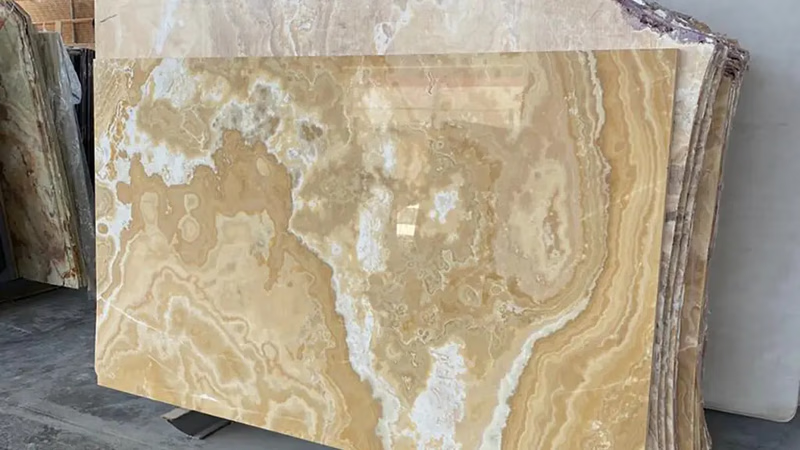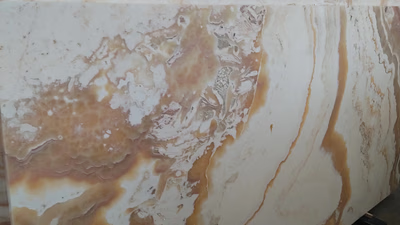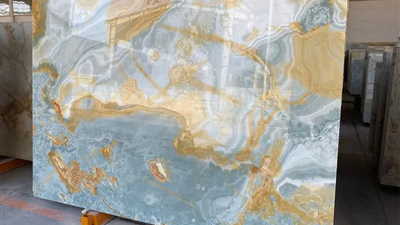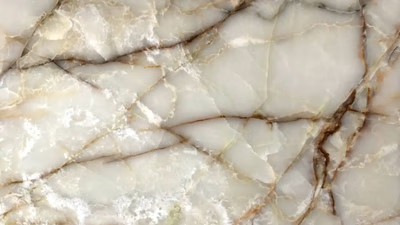
Explore the beauty of marble rocks in various colors.
Marble occurs in various colors, including white, gray, black, green, pink, and brown. The coloration is influenced by impurities present during its formation. One of the most distinctive features of marble is its veining patterns. These veins are created by mineral impurities, such as clay, silt, sand, or other minerals. Veins can be fine or coarse, and they often add to the aesthetic appeal of the stone. The grain of marble refers to the size and arrangement of its mineral crystals. Marble can have a fine, uniform grain or a coarser grain, depending on factors like the original limestone's composition and the intensity of metamorphism. Marble has a moderate to high luster, which means it exhibits a shiny or reflective surface. The luster can vary depending on the specific type of marble.
Marble is relatively soft compared to other stones. It has a hardness of about 3-4 on the Mohs scale, which means it can be scratched by harder materials. This property makes marble susceptible to wear and damage over time. While marble is not as durable as some other stones, it can still withstand normal wear and tear. However, it is more susceptible to staining, etching, and scratching compared to harder rocks like granite. Marble is a porous material, which means it has tiny interconnected spaces between its mineral grains. This porosity makes it more prone to absorbing liquids and can lead to staining if not properly sealed or maintained.
Marbles are rocks with simple mineralogical composition, but despite this, investigations on weathering phenomena of marble artifacts show very distinct behaviour for different marble types. This is largely due to the extremely anisotropic physical properties of calcite crystals and therefore of the rock fabric, i.e. the microstructure (grain size, grain aspect ratio, grain-shape preferred orientation) and the texture (crystallographic preferred orientation) of the rock. A rock fabric is the result of all the processes that the rock experiences throughout its geological history. Usually is the result of polyphase deformation events and metamorphism that occurred over a long time in varying conditions of pressure, temperature, types of deformation, chemistry of nearby rocks, etc.
Many samples of marble rocks shows a strong directional dependence of thermal strain, this occur notably in rocks with a strong crystallographic preferred orientation, i.e. in rocks where syntectonic recrystallization led to development of a strong texture in rock. Marble is a metamorphic rock of limestone by subjected to the heat and pressure. This stone with a very beautiful and pleasant appearance has many applications in making all kinds of stone artifacts as well as many functions as a building stone.
Marble is relatively easy to work with due to its softness. It can be cut, shaped, and carved into various forms, making it a popular choice for sculptures, architectural elements, and decorative objects. Marble has good heat resistance, making it suitable for use in areas like fireplaces and kitchen countertops. However, it is still advisable to use trivets or hot pads to protect the surface from direct heat exposure. Marble requires regular maintenance to preserve its appearance. It is important to clean up spills promptly, avoid using abrasive cleaners, and periodically seal the surface to protect against staining.
-

Selecting the right type of marble is crucial for its intended use, whether for flooring, countertops, or decorative accents. Factors such as color, veining patterns, durability, and maintenance requirements should be considered. Proper surface preparation is essential; the area must be clean, level, and free from debris. For flooring installations, marble tiles or slabs should be adhered using thin-set mortar or adhesive with careful alignment and spacing. Grouting and sealing are necessary to prevent staining and moisture penetration. In kitchen and bathroom applications, professional stone fabricators are recommended for cutting and shaping marble slabs to fit specific dimensions. Regular maintenance with pH-neutral cleaners is advised to preserve the surface. Marble can also enhance aesthetic appeal as wall cladding; proper installation involves ensuring a clean surface and using adhesive or mortar effectively.
Custom architectural elements like columns and moldings can be crafted from marble by skilled artisans. Overall, understanding the properties of different marble types and their applications can lead to successful installations in various settings.
-

West Asian marble stones are characterized by diverse textures and veining patterns, ranging from fine grains to pronounced linear or wavy veins. The color palette includes classic whites and beiges, as well as shades of brown, gold, gray, and green, influenced by mineral composition and geological processes. These marbles are durable and suitable for various applications due to their strength and resistance to wear. Historically significant, Middle Eastern marbles have adorned iconic structures like the Taj Mahal and Alhambra. Notable varieties include Carrara marble, known for its fine texture; Emperador marble with its rich brown tones; Crema Marfil featuring subtle veining; and Jerusalem Gold marble with its golden hues. Each type is valued for its aesthetic appeal in both traditional and contemporary designs. The region"s marble industry continues to thrive, producing high-quality stones that enhance the elegance of spaces while offering practical benefits such as heat insulation and anti-allergy properties. Marble"s unique features make it a sought-after material in construction and design.
-

Marble powder, derived from grinding marble, serves multiple roles in pharmaceutical and industrial applications. In pharmaceuticals, it acts as an excipient, enhancing tablet hardness and stability while being a key ingredient in antacid formulations due to its calcium carbonate content. This property helps alleviate symptoms of acid reflux and heartburn. Beyond pharmaceuticals, marble powder is utilized in soil amendments to improve fertility and pH levels, as well as in water treatment processes to remove impurities. Its versatility extends to various industries where it functions as a filler or additive in paints, plastics, and cosmetics. The quality of marble used is crucial for its effectiveness across these applications, necessitating adherence to regulatory standards. Additionally, marble"s hardness allows it to be employed as an abrasive material for cleaning and polishing surfaces. Overall, the diverse applications of marble powder highlight its significance beyond traditional uses in construction. "
-

Marble is a highly sought-after building stone known for its luxurious appearance and versatility in various applications. It is commonly used in high-end residential and commercial spaces, enhancing the ambiance with its polished surface that reflects light. Marble serves as wall cladding, flooring, and decorative elements like moldings and medallions, adding sophistication to interiors. Its durability makes it suitable for outdoor landscaping features such as pathways and fountains. The specific type of marble, including color and veining patterns, influences its application suitability. While marble is more expensive than other stones like travertine and granite, its superior quality justifies the cost for many buyers. Key applications include exterior design, kitchen countertops, bathroom vanities, stairs, and fireplace surrounds. However, maintenance is crucial due to marble"s susceptibility to staining and etching.
Overall, natural marble has been a favored choice in architecture for centuries due to its unique beauty and functionality. "
-

Marble is a metamorphic rock characterized by its diverse colors, veining patterns, and moderate to high luster. The coloration results from impurities during formation, while the veining adds aesthetic appeal. Marble"s grain can vary from fine to coarse based on its original limestone composition and metamorphic intensity. Although it is softer than other stones, with a Mohs hardness of 3-4, marble is susceptible to scratching and staining due to its porous nature. Proper maintenance, including sealing and prompt spill cleanup, is essential for preserving its appearance. The unique physical properties of marble are influenced by geological history, including pressure and temperature conditions that affect its microstructure. Despite its vulnerabilities, marble remains a popular choice for sculptures and architectural elements due to its workability and heat resistance. Regular care can enhance the longevity of marble in various applications. "





